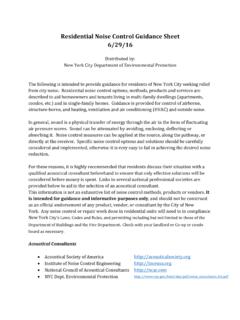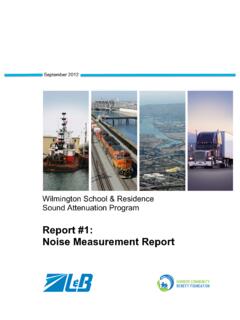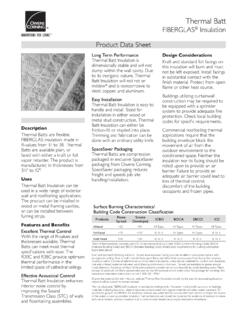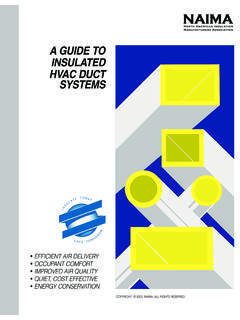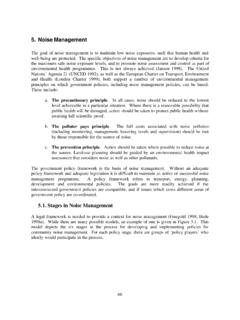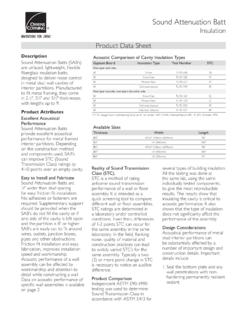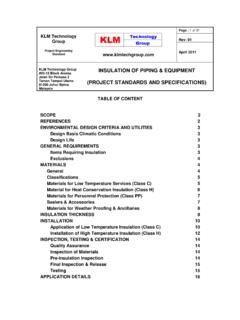Transcription of Heavy Construction Equipment Noise Study Using Dosimetry ...
1 Heavy Construction Equipment Noise Study Using Dosimetry AND TIME-MOTION STUDIES Ellsworth Spencer National Institute for Occupational Safety and Health Pittsburgh Research Laboratory 626 Cochrans Mill Road, Pittsburgh PA 15236 ABSTRACT Noise induced hearing loss continues to afflict workers in many occupational settings despite longstanding recognition of the problems and well-known methods of prevention and regulations. Sound levels associated with Heavy Construction Equipment range from 80 to 120 dB(A) and power tools commonly used in Construction produce sound levels up to 115 dB(A).(1) The focus of this research was to determine the Noise exposures of Heavy Construction Equipment operators while documenting the workers tasks, ( hauling, moving, and/or pushing Construction material). Time-motion studies were performed at the Construction sites and were used to correlate the Noise dosage with the work performed by Equipment operators.
2 The cumulative dose for the operator was then plotted with references to work tasks, to identify the tasks that caused the greatest Noise exposure. Three Construction sites were studied for this research located in the western Pennsylvania and eastern Ohio areas. The types of Construction Equipment studied included asphalt pavers, backhoes, bulldozers, compaction Equipment , excavators, haul trucks, telehandlers, and wheeled loaders. The results showed that bulldozer operators consistently had the highest Noise exposures, ranging from a NIOSH REL (Recommended Exposure Limit) dose of 844% to 25,836% and an OSHA PEL (Permissible Exposure Limit) dose of 139% to 1,397%. INTRODUCTION The National Institute for Occupational Safety and Health (NIOSH) estimates that at least 420,000 Construction workers are exposed to potentially hazardous Noise levels above 85 dB(A).
3 (2) In the Construction industry, Heavy Construction Equipment is a major contributor to high Noise levels at most job sites. This research was performed to identify the overall A-weighted sound levels of Heavy Construction Equipment and the resultant occupational Noise exposure of the operators of Heavy Construction Equipment during normal operation. The data are presented by occupation and individuals are not Table 1: Internal dosimeter settings.(2), (3), (4) Dosimeter No. Parameters Settings Designation Dosimeter 1 Weighting Threshold Level Exchange Rate Criterion Level Response Upper Limit A 80 dB 3 dB 85 dB Slow 140 dB NIOSH Recommended Exposure Level (REL) Dosimeter 2 Weighting Threshold Level Exchange Rate Criterion Level Response Upper Limit A 40 dB 3 dB 85 dB Slow 140 dB Wide Range Dosimeter 3 Weighting Threshold Level Exchange Rate Criterion Level Response Upper Limit A 90 dB 5 dB 90 dB Slow 140 dB OSHA Permissible Exposure Level (PEL) Dosimeter 4 Weighting Threshold Level Exchange Rate Criterion Level Response Upper Limit A 80 dB 5 dB 85 dB Slow 140 dB OSHA Action Level identified.
4 Dosimeters were used to acquire the dynamic Noise levels of the Heavy Construction Equipment and calculate the operator s daily Noise dose over a full shift Using NIOSH, and OSHA criteria. General Instrument and Measurement Information The dosimeter selected for this research was the Larson-Davis SparkTM 705+ dosimeter. This dosimeter was used because it is capable of measuring and recording dose with four separate Noise criteria and capable of sampling at a 1-second interval over 13 hours.(3) The dosimeters were setup as shown in Table 1. The results from the OSHA settings are used primarily for informational purposes, such as a reference for those who must comply with the OSHA regulations. The areas where Noise controls are most needed will be determined by examining the percentage of workers exceeding 100% dose based on the NIOSH REL. A Personal Digital Assistant (PDA) with subject observation software or a watch combined with handwritten notes were utilized to conduct task observations on Equipment operators to define worker activities, worker behaviors, and machine functions occurring during the work shift.
5 Data collection Dosimetry measurements were made at voluntary Construction sites. For the Dosimetry measurements, the machine type, manufacturer, model, and serial number were documented via handwritten notes on data sheets. The engine manufacturer, model number, power rating, and rated speed were also recorded. In addition, the condition of the machine, existence of engineering Noise controls, and modifications to the machine were noted. When practical, digital pictures were taken of each side of the machine, the engine compartment, and the operator station. Further, close-up pictures were taken of installed engineering Noise controls and observed damage such as broken windows or missing door seals were noted. The dosimeters were calibrated prior to and after the measurement and the dosimeter microphone was clipped to the midpoint of the worker s shoulder with the diaphragm pointing up.
6 (4) The time that the dosimeter microphone was first placed on the worker and the time of removal were documented. Data analysis plan The Dosimetry results were examined with the aid of task observations to determine the tasks, behaviors, and machine operations that result in the highest Noise exposures for the worker. PDAs with subject observation software or a watch combined with handwritten notes were utilized to conduct task observations on Equipment operators to document worker activities, worker behaviors, and machine functions performed during the work shift. To ensure consistency in the recording of relevant worker activities, worker behaviors, and machinery functions among multiple observers, pre-defined activities were programmed into the PDA software or common terminology were used with handwritten notes based on preliminary field observations and discussions with operators.
7 Documenting worker activities enables researchers to determine sound levels at the operator ear under field conditions. Sufficient data are collected to document and determine where Noise control development is necessary by identifying the machines whose operators were over-exposed to Noise with the A-weighted sound levels in excess of 85 dB at the operator s position. The Dosimetry results were downloaded into a searchable database, the task observations were imported into an Excel Dosimetry macro to facilitate determination of the significant contributors to the workers Noise dose. RESULTS Table 2 shows the range of time-weighted average Noise doses for the length of time the operator was monitored. The variance in the operator s dose for a specific machine can be attributed, but not limited to: hours worked, the monitoring of different operators, the operators degree of expertise, the condition of the terrain, the presence of or the proximity of noisy Equipment , and quantity of work done.
8 For bulldozers, the age, size, and work-cycle were all factors affecting the operator s dose. The bulldozer operators were consistently overexposed to Noise based on both the NIOSH REL and OSHA PEL criteria. The higher operators Noise doses came primarily from the largest bulldozers, such as the Caterpillar D8H and D9G Bulldozers which had only Roll-Over and Falling-Object Protection Systems, (ROPS/FOPS) and only stack exhausts without mufflers. The Table 2: Operator s dose ranges. Machine NIOSH REL OSHA PEL Monitor Time (Number Sampled) % Dose Range % Dose Range (minutes) Bulldozer (10) 844 - 25,836 139 - 1,397 362 - 630 Older Dozers, No Cabs 6,557 - 25,836 523 - 1,397 362 - 630 Newer Dozers, with Cabs 1,245 2,458 191 - 356 420 - 630 Newest Dozer, No Cab 844 139 575 Hand Saw (2) 4,094 - 9,194 173 - 301 74 - 164 Road Grader (1) 3,023 252 630 Road Saw (2) 1,242 - 2,090 108 - 265 155 - 415 Haul Truck (6) 28 492 2 72 479 - 630 Tele-Handler (1) 472 64 463 Asphalt Paver (3) 150 460 17 76 328 - 550 Front End Loader (4) 18 200 2 17 500 - 539 Excavator (4) 7 155 0 16 480 - 630 Plate Tamper (3) 62 146 7 23 508 - 510 Multi-Machine (17) 31 - 3,084 2 392 70 - 630 exhaust stacks on these machines ended at approximately the height of the ROPS/FOPS.
9 The A-weighted equivalent continuous sound levels (Leq) measured with the dosimeters ranged from 104 to 108 dB for the bulldozers. The older Caterpillar D8H and D9G Bulldozers were built from the late 1960 s to early 1970 s, but appeared to be in good condition despite their age. The newer Caterpillar D8N Bulldozers had cabs with ROPS protection. It was observed that the cabs had little or no sound absorbing material inside. The seals around the cab doors were in poor condition. The operators were observed to operate the Caterpillar D8N Bulldozers with a combination of doors and/or windows open, thereby greatly reducing the ability of the cab to protect the operators from Noise . The air conditioning units on the Caterpillar D8N Bulldozers were not functional. If the air conditioning units worked, perhaps the workers would use the air conditioning and keep the cab doors and windows closed.
10 The newest bulldozer studied, a Caterpillar D6 MXL, had Noise controls consisting of acoustic foam on the ceiling of the ROPS/FOPS, an exhaust muffler and an enclosed engine compartment. Even with no cab, the Caterpillar D6 MXL Bulldozer had the lowest recorded operator s dose of all the bulldozers. The hand saws, which were gas powered, used 6 abrasive circular-disk blades to cut re-bar from broken concrete slabs. The saw operator was exposed to Noise from the cutting operation and the exhaust of the engine. The road grader had a cab, but no insulation on the walls or a floor pad, and the doors were left open during operation. The road saws had 26 toothed circular blades that were used to cut a concrete road into approximately 6 by 6 slabs, so they could be removed easily. The road saw operators were not as close to the cutting operation as were the hand saw operators, and since the road saws were automated and both had good mufflers, the operators were exposed to less Noise than the hand saws.










